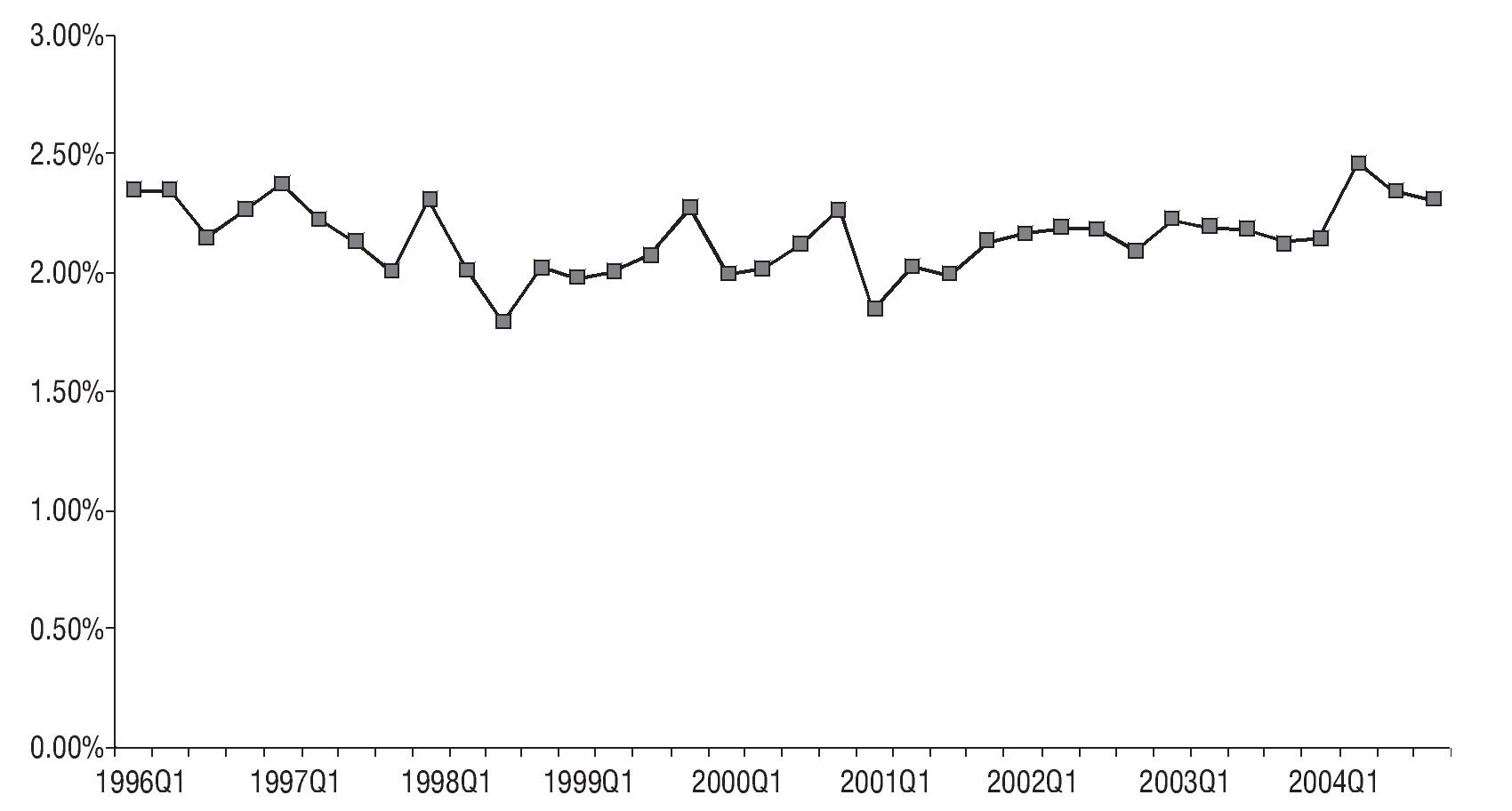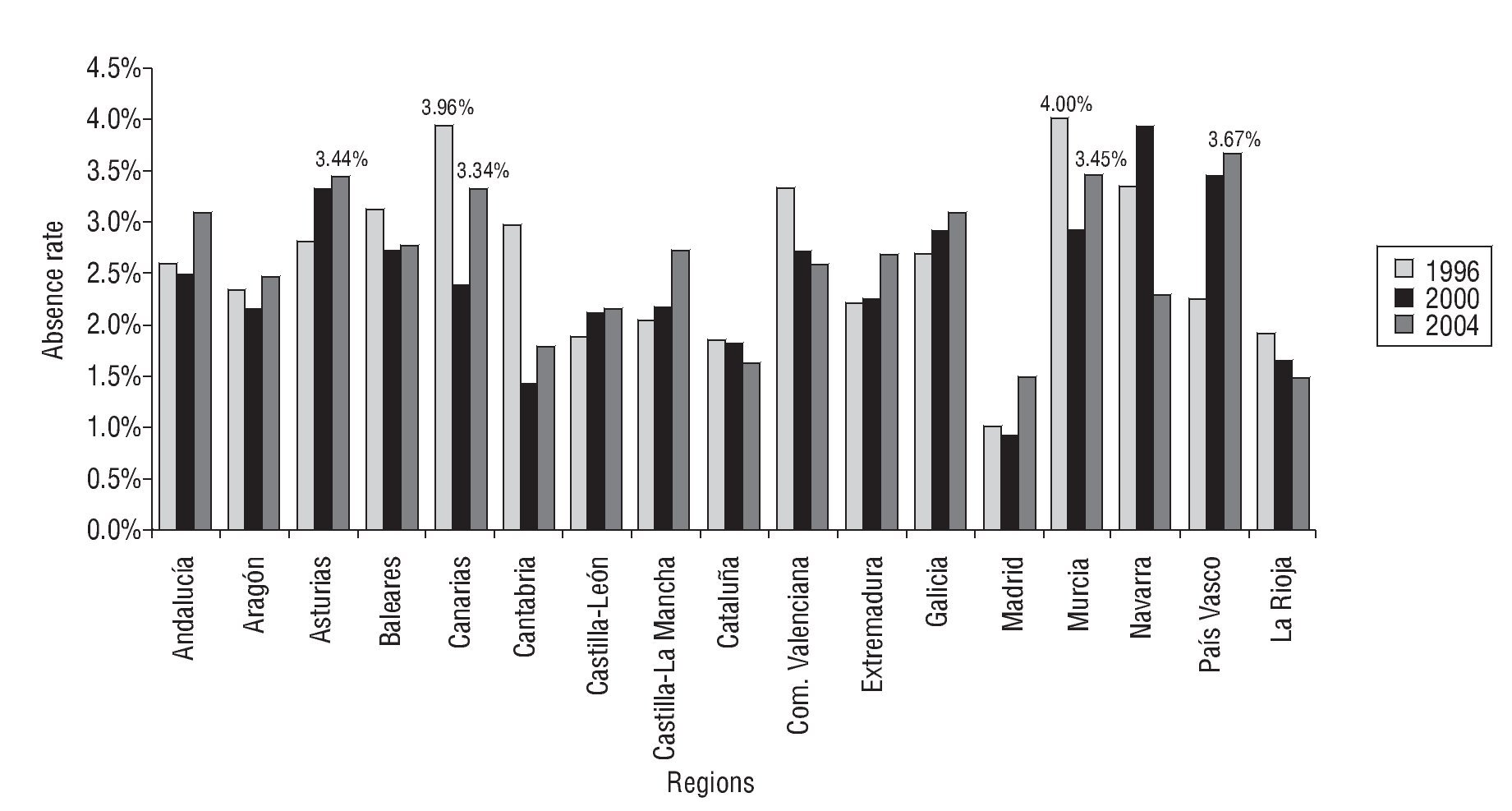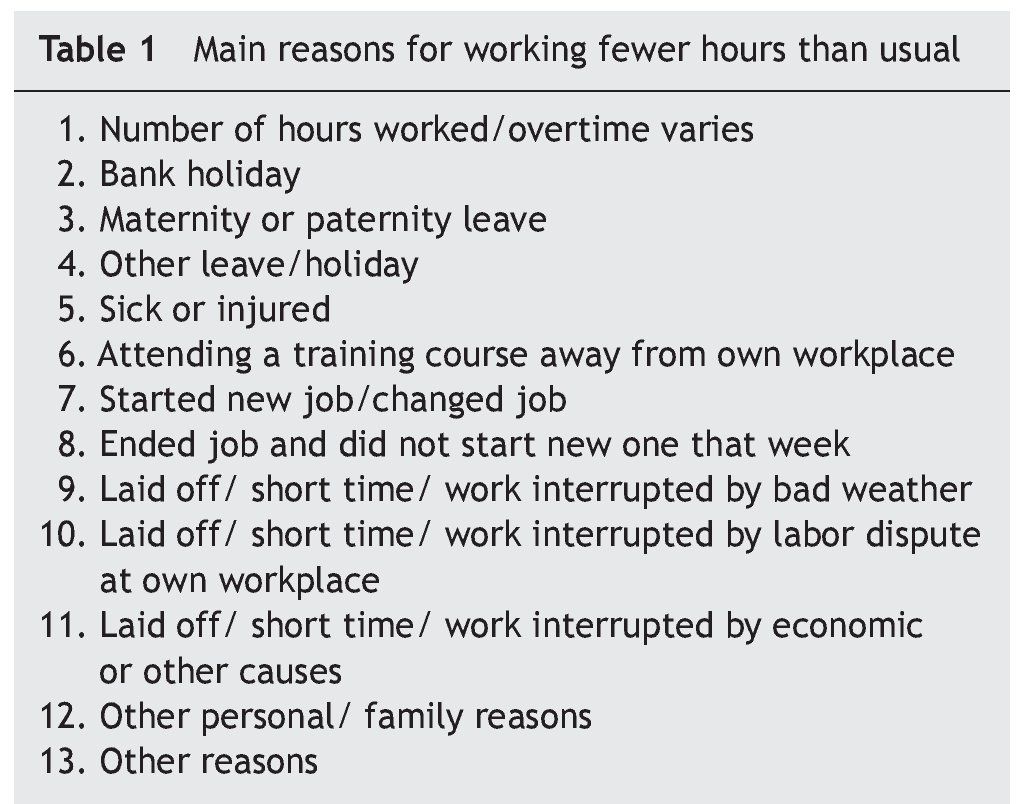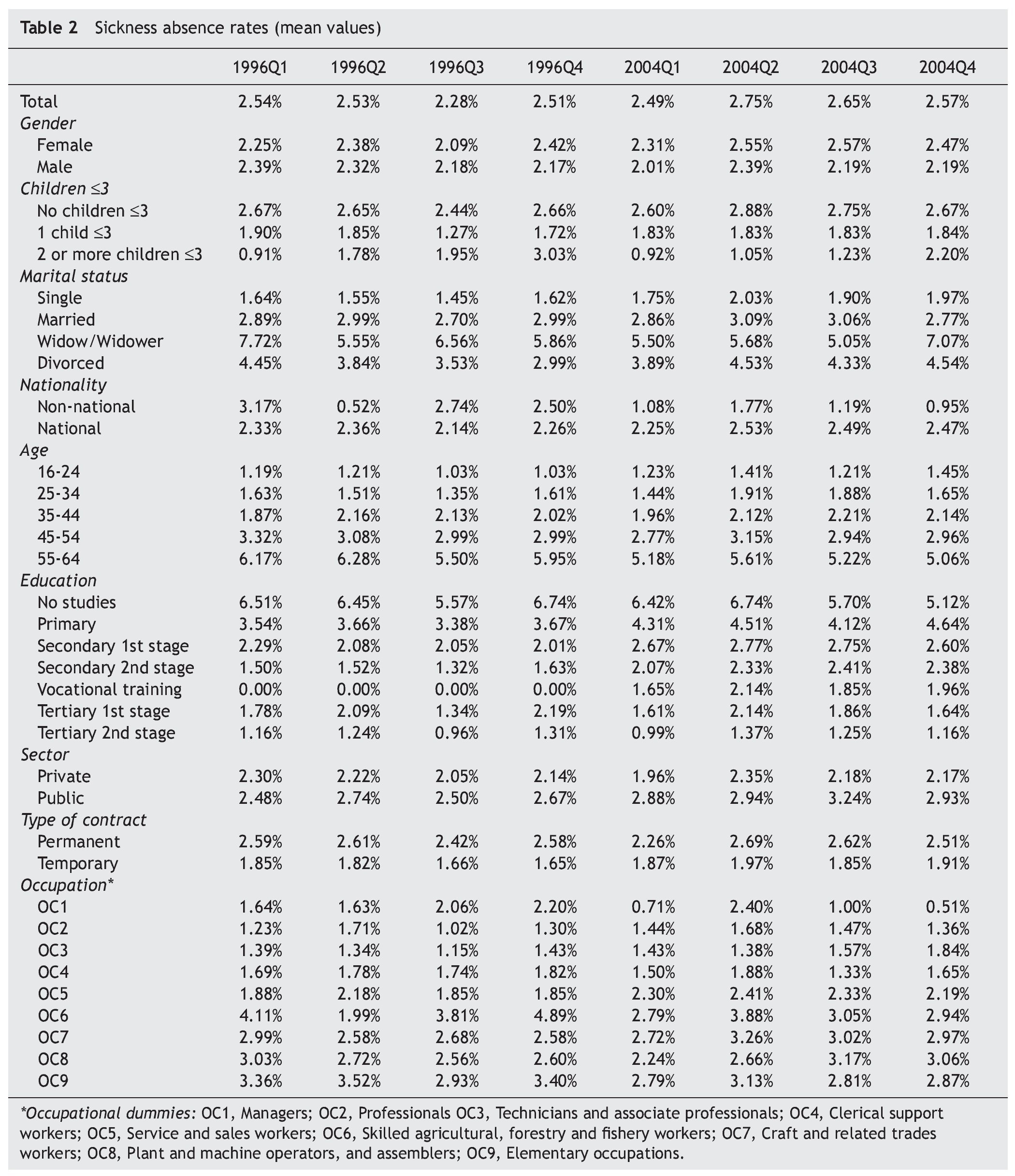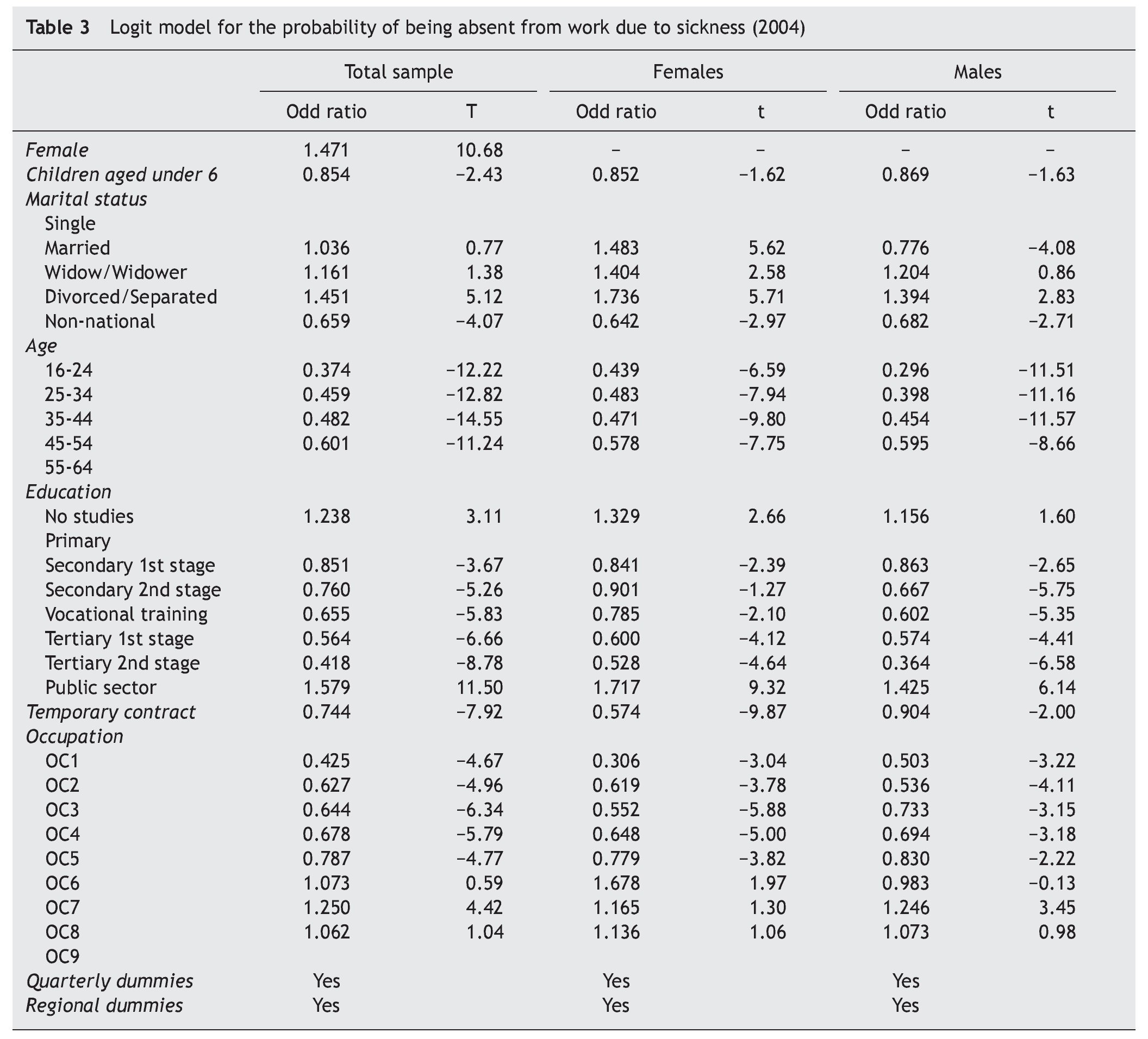This paper aims to highlight the trends of absenteeism among Spanish employees using Spanish Labor Force Survey (S-LFS) micro-data. Particular attention is paid to the main demographic and workplace characteristics that increase the rates of sickness absence. In general terms, the sickness absence rate varies from 2% to 2.5%, and the values have remained stable during the period 1996-2004. Females, older workers, and public sector employees are more likely to be absent from work as a result of sickness. In contrast, the risk of sickness absence is reduced with job insecurity, as suggested by the lower rates of absenteeism among temporary workers. Finally, the results show that socio¿economic status - measured by occupation and educational attainments - plays a role in explaining absenteeism due to sick leave.
El presente artículo pone de manifiesto las tendencias de absentismo laboral en España a partir de microdatos de la Encuesta de Población Activa (EPA). Hemos prestado una especial atención a las principales características demográficas y del lugar de trabajo que aumentan las tasas de absentismo por enfermedad. En general, la tasa de absentismo por enfermedad oscila entre el 2 y el 2,5%, valores que se han mantenido estables durante el periodo 1996-2004. Las mujeres, las personas de avanzada edad y los funcionarios suelen ausentarse más del trabajo por problemas de salud. En cambio, el riesgo de absentismo por enfermedad se reduce con la inseguridad laboral, tal y como sugieren las bajas tasas de absentismo encontradas entre los trabajadores temporales. Por último, los resultados indican que el estatus socioeconómico, medido según la ocupación y el grado de formación, es uno de los factores que nos pueden ayudar a explicar el absentismo por baja laboral.
1. Introduction
The magnitude of the sickness absence has increased attention towards this labor market phenomenon, its causes and major consequences. Absenteeism is an important part of the individual decision on actual working hours. It might be an efficient individual response in the presence of institutional constraints - such as minimum working hours - that affect an individual's choice between work and leisure (Dunn and Youngblood, 1986). However, significant efficiency costs may arise when absence costs are not internalized by workers. In particular, this moral hazard leads to lower values of output and employment in equilibrium, owing to the imperfect substitutability of absent workers. If insurance costs are mainly borne by the government, as is the case in most European countries, significant fiscal costs will also arise.
Employers have also become aware of the direct and indirect costs of sickness absence. The direct costs include statutory sick pay, the cost of replacement staff and loss of output. Indirect costs, which are difficult to quantify, are also related to sickness absence. These include low morale among staff who have to carry out the extra work for those who are absent, the cost of managing absence and the impact on training and development, all of which have an impact on the overall levels of the organization's output.
A large part of the literature is based on the social and economic costs of absenteeism. Its incidence and the effect it may have on the welfare of EU citizens have made this labor market phenomenon gain great importance over recent decades. However, in the design of the most suitable policies for reducing sickness absence and its major costs, it is important to examine which demographic and workplace characteristics are more likely to increase these absenteeism rates. This is precisely the purpose of the present study. Using data from the Spanish Labor Force Survey (1996-2004) provides evidence for the proportion of contracted work hours lost due to sickness absence, its evolution over time and its main determinants.
The rest of this paper is organized as follows. Section 2 provides a review of some papers that discuss the main factors affecting absenteeism. Section 3 describes the statistical procedure for computing sickness absence rates. In Section 4 we present the data set, the descriptive statistics and trends on absenteeism among Spanish employees. The estimation results are reported in Section 5. Finally, Section 6 provides a conclusion.
2. Determinants of sickness absence: a review of the literature
The literature on absenteeism has mainly focused on the analysis of the influence of different factors on sickness absence rates (see Brown and Sessions, 1996). Many of them are related to the labor supply side. To the extent that demographic characteristics affect individuals' preferences between labor supply and leisure, they become significant determinants of absenteeism (Drago and Wooden, 1992). In general, sickness absence is observed at a higher level among females, singles, blue-collar workers and less educated employees, as well as those working shifts and those with tenure contracts. Finally, absenteeism is found to be positively related to age.
Absenteeism is also influenced by workplace characteristics. There are certain physical and psychological job characteristics such as working hours, physical demands of the job, non-pecuniary advantages of the job and working relations that have an important role to play in determining work-related stress. At the same time, several studies in behavioral sciences have shown that absenteeism is linked to work stress. This link between job stress and absence from work was first suggested by Hill and Trist (1955). Later, Frankenhaeuser and Gardell (1976) examined employees' autonomy in the workplace and showed that that workplaces characterized by low worker-control and autonomy created stress, which resulted in absenteeism. Similar results were also reported by Spector et al., (1988). More recently, the paper by Leontardi and Ward (2002) examines both the determinants of work¿related stress and its importance as a predictor of individuals' quitting behavior and the rate of absenteeism. For this purpose they use multi-country data from the 1997 wave of the International Social Survey Program (ISSP). This data set provides reliable and standardized information on stress across OECD member states.1 The results suggest that certain physical and psychological job characteristics such as working hours, physical demands of the job, non-pecuniary advantages of the job, and working relations have an important role to play in determining work-related stress. Females report higher stress levels than men. Stress significantly increases with working hours - for all country groups and for both men and women. Stress also significantly increases with income while significant evidence exists that stress levels experienced vary according to occupation. Job stress is found to significantly increase with a higher educational level, when married, when managing people, being a trade union member, but decreases for public sector workers. Regarding the relationship between work-related stress and absenteeism, the analysis reveals workers most at risk from absenteeism are female workers, the lower skilled, lower educated and trade union members. Furthermore, those individuals reporting at least some stress in their current position are 8% more likely to be absent than those with no stress at all, and the probability increases with successively higher job stress, reaching 13% for those reporting being always stressed at work.
The type of employment contract has been also been found to influence rates of absenteeism due to sickness. There is evidence that temporary workers, who enjoy lower employment protection, tend to be less sickness prone than permanent workers. In the case of Spain, the study by Jimeno and Toharia (1996) uses data on absenteeism provided by the Spanish Labor Force Survey to examine the effect of the type of contract on workers' effort choice. They estimate the effects of a range of personal and job characteristics, including the type of contract as an explanatory variable, on the probability that a worker had worked less than the usual work hours. The main finding is that, after controlling for individual and job characteristics (including accident rates), permanent employees exhibit a probability of being absent from work which is about half a point higher than the corresponding probability for fixed term employees. This suggests that legislation on job protection may have relevant consequences regarding workers' performance.
Unionization is another factor that affects absenteeism. Some studies have used the exit¿voice hypothesis, established by Freeman and Medoff (1979) and Freeman (1980) in order to examine the relationship between absenteeism and the presence of organized labor in firms. The effect of unionism on absenteeism using the exit¿voice model was first studied by Allen (1984). Using the first five waves of the PSID, this paper shows that union members are more likely to be absent than non-union workers. The study by Chaudhury and Ng (1992) also finds that unionization increases the total number of days lost due to absenteeism, using Canadian firm-level data. This positive correlation between absenteeism and unionization may be explained by the higher wages, higher sick pay or better working conditions enjoyed by union workers. More recently, the study by García¿Serrano and Malo (2004) extended the analysis of the impact of collective voice institutions under different settings of absenteeism. They postulate the hypothesis that in Spain, absenteeism should be greater when there is a collective agreement at firm level.2 In order to contrast this hypothesis, they use a survey of large firms (Survey of Economic Situation provided by the Spanish Ministry of Labor and Social Affairs). The paper uses quarterly information on large plants (500 or more employees) for the period 1993:1-2002:1. They estimate the occurrence of absence and the absence rate separately, using a two-stage Tobit procedure (Drago and Wooden, 1992). The main finding of the paper is a robust positive influence of collective agreements at firm level on absenteeism (on the probability of having positive absenteeism and on absence rates). This positive correlation may be understood as the result of the greater protection of workers' rights, when workers are able to organize themselves (Allen, 1984). Alternatively, workgroup norms considerations may also play a role, since cohesive workgroups may engage in more absenteeism as a form of conflict (Drago and Wooden, 1992).
3. Statistical procedure
In order to quantify rates of sickness absence we have followed Ercolani (2006). Absence rates due to sickness are calculated as the ratio of hours reported absent due to sickness (excluding overtime) to contracted hours (excluding overtime). More precisely, the rate is defined as follows:
where the index j denotes any characteristic(s) of interest, such as year, gender, age, region, etc. Ai indicates the number of hours the individual i is absent during the reference week due to sickness, and Ci represents the corresponding number of hours contracted for said individual. Finally, Āj and Cj denote, respectively, the mean values of hours absent and hours contracted.
However, in order to obtain sickness absence rates that are representative for Spanish employees, we followed a weighting approach. Thus, we define Wj as the weighted rate of sickness absence, which is calculated by taking the ratio of the weighted mean of sickness absence with the weighted mean of work hours contracted.
where wij is the weight for each individual i with characteristics j.
4. Data set and descriptive analysis
4.1. The Spanish Labor Force Survey
The Spanish Labor Force Survey (S-LFS) is a continuous quarterly survey that targets households, and its main objective is to obtain data on the labor force (which is subcategorized by the employed and unemployed), and on people outside the labor market. The theoretical sample varies from 65,000 households per quarter to approximately 60,000 households actually interviewed, which implies around 180,000 people.
The Spanish LFS collects information from respondents about work during "a reference week", which is the last full week before the interview date. Specifically, individuals are asked if they did any paid work or if they were away from a job or business that they would normally attend. Several questions in the questionnaire are used to compute the number of hours lost due to sickness. The first one is: "Thinking of your (main) job/business, how many hours per week do you usually work? Please exclude meal breaks and overtime". The response to this is interpreted as the usual contracted weekly hours, Cui, of individual i. Information on the number of non-overtime hours they actually worked in the reference week, Cwi, is extracted from the question: "Thinking now about the seven days ending Sunday [date], how many hours did you actually work in your (main) job/ business? ¿ Please exclude meal breaks and overtime". Finally, in order to check that actual work hours are in fact lower than the usual number of work hours, the respondents are asked: "What was the main reason that you did fewer hours than usual/were away from work in the week ending Sunday [date]?". The possible answers to this question are reported in Table 1. We define an individual indicator si that takes value 1 when the interviewer answered "5-sick or injured", and takes value 0 otherwise.
In sum, sickness absence rates are constructed using three sources of information for any individual in a situation of employment: i) how many non-overtime hours he/she usually works per week, Cui; ii) how many non-overtime hours he/she actually worked in the reference week, Cwi, iii) whether any reduction in hours is due to sickness, si. With this information, we construct the variables Ai and Ci, defined in Section 3, as follows:
4.2. Sickness absence rates: Descriptive analysis
In Figure 1 rates of sickness absence over time are reported. It is worth noting the steady and low levels of sickness absence over the period 1996-2004. In general terms, the rate varies from 2% to 2.5%. These results are very close to the 2.8% registered in Europe for the period 1995-2003 (see the study by Bonato and Lusinyan, 2004).
Figure 1 Sickness absence rates (1996Q1-2004Q4).
In Figure 2 sickness absence rates are shown for 17 geographical areas (all Self¿Governing Regions except Ceuta and Melilla). It is important to point out that individuals are classified according to the region of their usual residence, rather than the region where they work. As can be observed, significant regional differences become apparent, with absenteeism rates especially high in regions like Canarias and Murcia in 1996 (around 4%), and Asturias, Canarias, Murcia and País Vasco in 2004 (around 3.5%). These numbers might suggest different attitudes to work and/or regional differences in managerial competences. Nonetheless, we have to keep in mind that the industrial structures differ considerably from one region to another.
Figure 2 Sickness absence rate by region.
Table 2 shows sickness absence rates for various demographic and workplace characteristics. With respect to the former, several interesting features are worth mentioning. Females exhibit higher rates of absenteeism in all quarters in 2004, while in 1996 gender differences are not so evident. Surprisingly, the presence of young children in the household does not increase the incidence of absenteeism, while marital status is significantly related to sickness absence rates. Comparing the two major groups, single and married people, the latter exhibit higher rates than the former. As might be expected, sickness absence rates significantly increase with age. In part, this is due to the positive correlation between illness and age, but it may also be due to the proximity to retirement age. With respect to education, the descriptive analysis shows a higher incidence of absenteeism among workers with the lowest educational attainments, while no clear pattern is observed regarding nationality.
Regarding workplace characteristics, I find that temporary workers, who enjoy lower employment protection, tend to be less sickness prone than permanent workers. A similar pattern is observed among private sector employees who are less likely to be on sick leave than those in the public sector. Occupation is also a key factor in determining sickness absence rates, with blue-collar employees exhibiting higher absence rates than white¿collar employees.
5. Estimation results
The descriptive analysis presented so far shows that various factors are related to sickness absence in isolation. In this section I shall provide a more detailed analysis on the main determinants for sickness absence rates. For this purpose I have taken quarterly data from 2004 and conducted a logistical regression analysis where the dependent variable is a dummy variable that takes value 1 if the individual has been absent from work because of sickness during the reference week. As explanatory variables, I consider both personal - gender, age, education, nationality - and workplace characteristics - type of contract, sector and occupation. Finally, both quarterly and regional dummies are included in the estimation. The results for the total sample and separately for males and females are reported in Table 3.
The estimation results reveal that females are significantly more likely to be absent from work due to sickness than males. Although there are no formalized theories that explain gender differences in sickness absence rates, empirical findings suggest that such differences exist. One way to understand it is to relate the disparity between men and women in sickness absence to the way they cope with adverse working conditions: men and women are generally different in how vulnerable they are to adverse working conditions (Koheler et al., 2006; Väänänen et al., 2003; Mastekaasa, 2000; Messing, 1998). Gender differences can also be explained by a combination of biological, psychological and socio-cultural factors. For instance, if women have to conciliate family and work activities they are more likely to have a higher level of 'life stress' and thus to be more vulnerable to work-related stress.
The presence of children in the household does not seem to increase the likelihood of absenteeism either for males or females. However, the effect of marital status significantly differs between males and females. Taking singles as the reference category, married females present a higher probability of being absent from work, while the opposite is observed among the male subsample.
Sickness absence is found to be positively related to age. This relationship between age and sickness absence, especially long¿term absence, can be partly explained by the positive correlation between age and the prevalence of chronic diseases. Furthermore, the results reveal that higher educational attainments are associated with lower rates of absenteeism due to sickness.
In line with the descriptive analysis, the estimation results reveal that increased job insecurity, inherent to temporary contracts, has a negative effect on absenteeism. Public sector employees are more likely to be on sick leave than those in the private sector. There may be several reasons behind these differences in absenteeism. One is that private employers have stronger incentives to prevent absence, since it is costly to the employer, whereas public employers have weaker direct incentives to minimize costs to their organization. Another explanation is based on the possibility of self-selection: workers with preferences for frequent absence self-select the public sector because of its higher degree of employment security.
The results also reveal remarkable differences in sickness absence rates between occupational groups. In line with the existing evidence, blue¿collar workers exhibit a higher sickness absence rate than white-collar workers (Taylor, 1979; Steers and Rhodes, 1984). This result could be partly attributable to the greater likelihood of injury at work in manual jobs.
6. Conclusions
In order to reduce the incidence of absenteeism due to sickness leave it is vital to understand the reasons behind it in more detail. This is the main purpose of the present paper. Using quarterly data from the Spanish Labor Force Survey for the period 1996¿2004, I have examined which demographic and workplace characteristics are more likely to increase the rates of sickness absence. For this purpose I followed the approach of Ercolani (2006) and computed sickness absence rates as the ratio of hours reported absent due to sickness to hours contracted.
In general terms, the sickness absence rate varies from 2% to 2.5%, and the values have remained stable throughout the period under consideration. Both the descriptive and the econometric analyses reveal that females are more likely to be absent from work due to sickness than their male counterparts. Furthermore, gender differences are found with regards to the effects of marital status on absenteeism, with married females being more likely to be absent from work than their single counterparts, while the opposite is observed among males. Age also plays a role in explaining absenteeism. In particular, the analysis confirms previous findings on the increasing prevalence of sickness absence among older workers.
Public sector absence rates exceed private sector ones. The disparity in these figures is often seized upon by conservative commentators as proof that the public sector has a "relaxed attitude" towards employees taking time off work when compared to the private sector. This result, then, calls for a more decided effort to prevent absenteeism in the public sector. The lower rates of sickness absence observed among temporary workers reveals that absenteeism is also related with job insecurity.
Finally, the results point out that socio-economic status plays a role in explaining the risk of sickness absence. This conclusion is extracted from the potential impact that occupation and education - closely related to socio¿economic status - exert on absenteeism.
Acknowledgments
The financial support from the European Commission through the research project "HEALTHatWORK: An Inquiry into the Health and Safety at Work; A European Union Perspective", HEALTH-F2-2008-200716, is gratefully acknowledged.
1. Spain is included in the analysis, together with Italy and Portugal, within the group of Mediterranean countries.
2. In the case of countries like Germany, absence rates should be higher in firms with Works councils.
Received January 24, 2012; accepted March 1, 2012
E¿mail address:maite.blazquez@uam.es
References
Allen, S.G., 1984. Trade unions, absenteeism, and exit¿voice. Industrial and Labor Relations Review 37(3), 331-345.
Barmby, T., Sessions, J.G., Treble, J.G., 1994. Absenteeism, efficiency wages and shirking. Scandinavian Journal of Economics 96, 561-566.
Barmby, T.A., Ercolani, M.G., Treble, J.G., 2004. Sickness absence in the UK: 1984-2002. Swedish Economic Policy Review 11, 65-88.
Barmby, T.A., Ercolani, M.G., Treble, J.G., 2002. Sickness absence: An international comparison. Economic Journal 112, F315-F331.
Bonato, L., Lusinyan, L., 2004. Work absence in Europe. IMF Working Paper No. 04/193.
Brown, S., Sessions, J.G., 1996. The economics of absence: Theory and evidence. Journal of Economic Surveys 10(1):23-53.
Chaudhury, M., Ng, I., 1992. Absenteeism predictors: Least squares, rank regression, and model selection results. Canadian Journal of Economics 3, 615-634.
Drago, R., Wooden, M., 1992. The determinants of labor absence: Economic factors and workgroup norms across countries. Industrial and Labor Relations Review 45, 764-778.
Dunn, L.F., Youngblood, S.A., 1986. Absenteeism as a mechanism for approaching an optimal labor market equilibrium: An empirical study. Review of Economics and Statistics 68(4), 668-674.
Ercolani, M.G., 2006. UK employees' sickness absence: 1984-2005. Discussion Papers 06-02, Department of Economics, University of Birmingham.
Frankenhaueuser, M., Gardell, B., 1976. Underload and overload in working life: Outline of a multidisciplinary approach. Journal of Human Stress 7, 129-170.
Freeman, R.B., 1980. The exit¿voice tradeoff in the labor market: Unionism, job tenure, quits, and separations. Quarterly Journal of Economics 94, 43-673.
Freeman, R.B., Medoff, J., 1979. The two faces of unionism. Public Interest 57, 69-93.
García¿Serrano, C., Malo, M.A., 2004. Absenteeism, exit¿voice, and collective bargaining. Unpublished paper.
Hill, J.M., Trist, E.L., 1955. A consideration of industrial accidents as means of withdrawal from the work situation. Human Relations 8, 121-152.
Jimeno, J.F, Toharia, L., 1996. Effort, absenteeism, and fixed term employment contracts. Revista Española de Economía 13(1), 105-119.
Kohler, J. M., Munz, D.C., Grawitch, M.J., 2006. Test of a dynamic stress model for organisational change: Do males and females require different models? Applied Psychology 55, 168-191.
Leontardi, R., Ward, M.E., 2002. Work-related stress, quitting intentions and absenteeism. IZA Discussion Paper No. 493, May.
Livanos, I., Zangelidis, A., 2010. Sickness absence: a pan-European study. Unpublished.
Mastekaasa, A., Dale-Olsen, H., 2000. Do women or men have the less healthy jobs? An analysis of gender differences in sickness absence. European Sociological Review 16, 267-286.
Messing, K., Tissot, F., Saurel-Cubizolles, M.J., Kaminski, M., Bourgine, M., 1998. Sex as a variable can be a surrogate for some working conditions: factors associated with sickness absence. Journal of Occupational and Environmental Medicine 40, 250-260.
Spector, P.E., Dwyer, D.J., Jex, S.M., 1988. Relation of job stressors to affective, health and performance outcomes: A comparison of multiple data sources. Journal of Applied Psychology 73(1), 11-19.
Steers, R.M., Rhodes, S.R., 1984. Knowledge and speculation about absenteeism. In: Goodman, P., Atkin, R. (Eds.), Absenteeism. Jossey-Bass, San Fransisco.
Taylor, D.E., 1979. Absent workers and lost work hours. Monthly Labor Review 102, 46-53.
Väänänen, A., Toppinen-Tanner, S., Kalimo, R., Mutanen, P., Vahtera, J., Peiró J.M., 2003. Job characteristics, physical and psychosocial symptoms and social support as antecedents of sickness absence among men and women in the private sector. Social Science and Medicine 57, 807-824.






